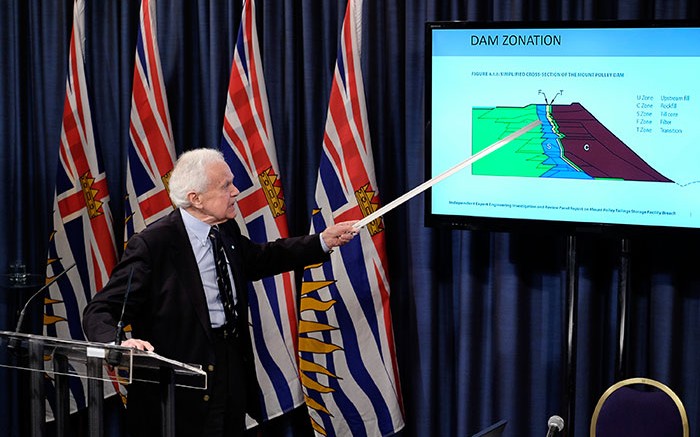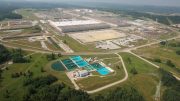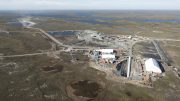The eagerly anticipated final report by the Mount Polley Independent Expert Engineering and Review Panel on the cause of the Aug. 4, 2014, failure of the tailings dam at Imperial Metals’ Mount Polley copper-gold mine in B.C. was delivered on Jan. 30, and the conclusions are damning of what have been considered “best practices” in the mining industry when it comes to tailings dam design.
The independent panel of geotechnical experts — comprising chair Norbert Morgenstern, Dirk van Zyl and Steven G. Vick — found that the Mount Polley dam was in effect an imposing giant with feet of clay: the massive dam structure in and of itself was well built and competent, but it had been built atop glacial lake sediments that were fatally weakened by the weight of the overlying structure, leading to a complete collapse of the entire dam starting from glacial clay deep in the foundation of the embankment and moving up into the dam structure.
The designers and builders of the dam didn’t know enough about the underlying glacial lake sediments because they hadn’t bothered looking hard enough or deep enough into these natural sediments to fully understand what they were dealing with.
Specifically, the panel said that “the design did not take into account the complexity of the sub-glacial and pre-glacial geological environment associated with the perimeter embankment foundation. As a result, foundation investigations and associated site characterization failed to identify a continuous glaciolacustrine (GLU) layer in the vicinity of the breach and to recognize that it was susceptible to undrained failure when subject to the stresses associated with the embankment.”
It’s not too hard to think of why that geological and geotechnical knowledge wasn’t obtained: it’s expensive to drill a bunch of tightly spaced holes deep into a thick layer of glacial lake sediments and carry out extensive geotechnical testing of the resulting cores; it’s much cheaper and faster to sample a lot less and then mathematically extrapolate those results over a wider area. More often that not, that’s a good enough method, but obviously this was not the case with Mount Polley.
But it was more than that: the panel found that the failure was triggered by construction of the downstream rockfill zone at a steep slope, and concluded that had the downstream slope been flattened, failure would have been avoided. In a too-little, too-late effort, that slope was in fact being flattened to meet its ultimate design criteria at the time of the accident.
On the positive side, the panel also concluded that there was “no evidence that the failure was due to human intervention or overtopping of the perimeter embankments and that piping and cracking, which is often the cause of the failure of earth dams, was not the cause of the breach.”
Morgenstern was blunt in his comments, describing the building of the dam on such weak, untested sediments as the equivalent of having created a “loaded gun” and the use of such a steep slope for the dam as having “pulled the trigger.”
Vick was just as damning at the panel’s press conference, stating that the panel “recognizes we can’t continue business as usual. No failures are acceptable under the task we’ve been given . . . We can’t continue to use technology that’s a hundred years old.”
The panel made seven recommendations to ensure this kind of breach isn’t seen again in the province: implement best available technology; improve corporate governance; expand corporate design commitments; enhance validation of safety and regulation of all phases of a tailings storage facility; strengthen current regulatory operations; improve regulator evaluation of ongoing facilities; improve professional practice; and improve dam safety guidelines.
Issues of civil or criminal liability and management oversight were not addressed in the study, but they will be by other ongoing investigations by B.C.’s chief inspector of mines and the Conservation Officer Service.
It certainly wasn’t business as usual at Imperial Metals’ offices in Vancouver and the Mount Polley mine on Feb. 3, as the police executed search warrants at both sites on behalf of the Conservation Officer Service. The service is an independent law enforcement arm of B.C.’s Ministry of Environment, and can recommend charges if warranted to the province’s Crown Counsel.





Be the first to comment on "Editorial: Mount Polley’s feet of clay"